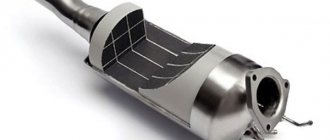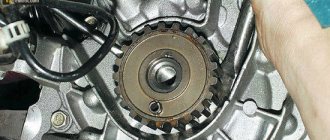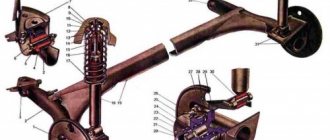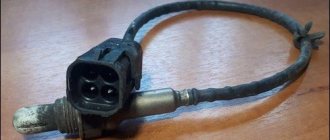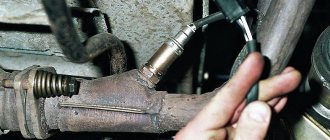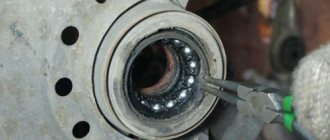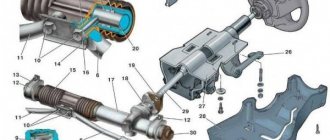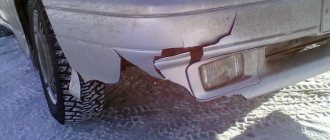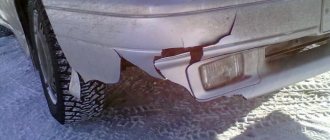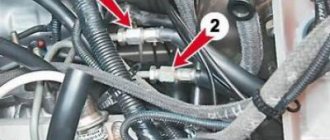After buying the car, I decided to get rid of the catalyst, since it tends to get clogged and replacing it is not cheap. Previously, on cars they stood where the resonator is and such a catalyst costs 3,000 thousand rubles. And now they have started to install them on the exhaust manifold (spider, pants, in general, whoever likes it more) and such a catalyst costs almost 10,000 thousand. Well, why do you need one like that, I thought and bought myself a replacement insert - a 4-1 spider from Stinger. The spider itself
I thought for a long time whether to change it at the service center or change it myself, because there is nothing complicated, and the service center will take a lot of money, so I decided to do this during the holidays. I arrived at the dacha, made myself a mini overpass to make it easier to get under the car, and then started disassembling it.
I dismantled almost half the car to get to this catalyst, removed the intake manifold, unscrewed all the hoses, screwed all the intake and exhaust manifolds with 13 nuts, so there are at least 30 of them screwed in there. When I got to the catalyst, I was thinking, will I put it all back together and won’t I have anything left over, as always? In general, an hour later I got to him and took off
Here it is in comparison with the new spider
Putting the whole thing back together, the work took about three hours. According to the first sensations, the car began to accelerate faster and the consumption was on average per 100 km. became 6.5-7 liters, but did not notice any significant changes. But what does the catalyst itself consist of?
Even after installation, the wire that comes from the lambda probe was a little short and I decided to fix this problem and make an extension cord, for this I bought two connectors (male/female) and twisted them together
Oh yes, after installing the spider, the check on the tidy lights up very rarely, almost never lights up and the on-board computer writes an error that the neutralizer is weak. I’m thinking about doing chip tuning, but somehow I have doubts, the consumption will increase at the same time, who will say anything about this, is it worth it or not?
Replacing the catalyst on a VAZ 2115 with your own hands
Catalyst for VAZ 2115
Every owner of a “tag” is once faced with a catalyst problem. And then he needs an urgent replacement of the catalyst on the VAZ 2115.
An old muffler often even sags so low that it clings to everything that lies incorrectly on the road surface. Of course, you can use fixing straps or wire, but this will not help.
In any case, the VAZ 2115 catalyst needs to be replaced.
VAZ 2114: replacing the catalyst with a flame arrester LADA Samara
Fans of the VAZ 2114 often subject their cars to experimental tuning of the exhaust system, trying to enhance or, conversely, weaken the sound of the muffler. Also, many owners of domestic cars are interested in professional approaches to replacing a catalyst or neutralizer, as well as what is the difference between them and, say, a flame arrester. This article will help you understand all the nuances of this issue, in the writing of which all the guys from our service center were involved. We hope that the material will be useful for our readers and fans of the domestic automobile industry.
WHY DO YOU NEED A CATALYST?
Usually, when it comes to a catalyst, most motorists only think of a muffler, or rather a can or pipe. In fact, the exhaust system of a car includes several elements: connecting pipes, muffler, resonator, corrugation, catalyst, etc. So:
- The catalytic converter, as the catalyst is called, is a fairly important element of the car and the entire exhaust system.
- One of the main functions assigned to it is the purification of exhaust gases that flow through the pipe. The latest Euro 2 standards require the presence of a catalyst in the exhaust system of the car and a special oxygen sensor.
- The neutralizer itself, despite the fact that it is made of metal and a massive body, is a rather fragile element. He is afraid of severe mechanical damage, and is also quite sensitive to low-quality fuel. Impurities and various dirt residues contained in low-quality gasoline remain on the walls of the catalyst, gradually accumulate there and lead to damage to the part. In Russian conditions, the catalyst fails very quickly. And if, usually, it is designed for 200,000 km of run, then if it comes into daily contact with Russian fuel, it will not withstand even 30,000 km of run.
It is useful to know what a catalytic converter is made of. And find out how this part works. As was said, it reduces the amount of harmful substances and impurities that any car with an internal combustion engine emits into the surrounding atmosphere. These are substances dangerous to human health, such as carbon monoxide, nitrogen oxide, etc.
For example, carbon monoxide is a real gas that has neither color nor odor. But it is precisely this that contributes to the appearance of cardiac colic and headaches in people.
As for the design of the catalyst, it consists of a ceramic or often metal honeycomb part. Why honeycombs?
Yes, because the design resembles a honeycomb. On top of these same honeycombs, special precious metals, most often platinum, are sprayed.
Although palladium catalysts are often used in the automotive industry of developed countries.
Palladium catalyst
Russian catalyst massacre. What's inside after 183,000 km?
According to statistics, owners of foreign cars encounter a faulty catalyst much more often than VAZ drivers. Haven't encountered a catalytic converter failure yet? Sooner or later it will happen anyway.
However, the difference is that replacing a faulty element in a VAZ is cheaper, and the repair itself takes a little time. “Foreign cars” immediately grab their heads when the catalyst breaks down. Often, purchasing imported spare parts costs 40-50 thousand rubles.
We cut the catalyst from the VAZ-2115
Not long ago, the author of the article discovered an old catalyst in his garage. It was removed from a VAZ-2115, which had driven a little over 180,000 km. It was not possible to find a practical use for the part, so the decision was made to cut it into pieces and see what was inside. Curiosity took over. In the end, car owners often suffer from faulty catalysts - it was interesting to study the “ins and outs” of the details.
No sooner said than done. Just 2-3 minutes of working with the grinder - and here it is, the result of the cut. We invite you to look at the photo, which clearly demonstrates the “insides” of the neutralizer.
The process of sawing with a grinder
Clean as glass?
What we saw shocked us! As a rule, catalyst failure is due to two reasons:
- The elements have melted. This problem is relevant for ceramic catalysts, but in our case it is metal.
- Due to poor quality exhaust, the honeycombs were clogged. It’s strange, but even after 180,000 km, the cells are almost clean.
To be more sure, we raised the catalyst and tried to look at it in the sun. Past again - it shines through. This indicates that the item is in excellent condition.
Source: pikabu.ru
Unfortunately, such a case is rather an exception to the rule. Owners of many foreign cars (especially Korean ones) complain about the catalyst crumbling after only 20,000 km. Such cases are not isolated.
How many kilometers has your catalyst traveled? Write about it in the comments - it’s always interesting to hear the opinions of other car enthusiasts. Thumbs up if you liked the article. And subscribe to our channel to keep abreast of all the latest news and events from the world of cars.
How to determine if the catalyst is clogged and what to replace it with
The catalyst is an integral part of the exhaust system.
It is designed to ensure that the remaining harmful substances in the exhaust gases burn out and are released into the atmosphere in the form of water and carbon dioxide.
In general, car owners do not care whether the exhaust gases from their car are harmful or not. If you suddenly become interested in the topic of the catalyst, you are most likely interested in a spacer, spider, replacement, or you have an error. Therefore, we will not go into theory, let’s move on to your requests.
Neutralizer
The catalyst lasts up to approximately 100,000 km, then it becomes clogged, crumbles, oxidizes, and chokes the engine. But in reality, mileage is limited by the quality of gasoline, the presence of additives, and the fuel mixture. Therefore, you can destroy the neutralizer with a couple of “free” gas stations, or by destroying one of the sensors, for example the mass air flow sensor, thereby changing the mixture.
Replacing the catalyst on a 16-valve VAZ 2114
On a VAZ 2114 with a 16-valve engine, the catalyst is structurally combined with the output manifold and is located in the engine compartment immediately behind the cylinder block. To replace it, a special insert is used, a zero-resistance catalyst, better known as a “spider”. Removing the catalyst and installing a spacer can also be done in a garage. To gain access, you will need to remove the fuel rail.
The peculiarity of removing the catalyst on 16-valve VAZ 2114 cars is that there are two lambdas. The first is installed on the catalyst itself and is responsible for setting the fuel mixture, and the second, “ecological”, is located on the flange after the catalyst. Its absence will inevitably cause a sensor error, a check engine indication, incorrect injection operation, increased fuel consumption and poor traction. There are two ways out of this situation.
- If you purchased a spider for one sensor, the ECU needs to be flashed from Euro-3 to Euro-2. In addition, the spider for one sensor has a drawback: the only thread for the lambda probe is located on the flange. To screw in the “injection” lambda, you need to assemble an extension cord from two male-female connectors and a wire.
- If there is a spider for two sensors, the “injection” lambda can be installed in its original place. The thread for the second sensor can be plugged or a “dummy” for the computer can be installed there. In the second case, flashing the ECU to Euro 2 will not be required.
Before removing the catalyst, you need to understand why it is needed. The power gain from this procedure is a myth. As well as the belief that an engine with a catalyst “does not breathe.” Removing a working cat (and if the odometer shows less than 100 thousand kilometers and diagnostics show the system is working, it works) will not add additional horses. However, the belief that driving with a clogged catalyst is more environmentally friendly than driving without it is also a fallacy.
Problems with the VAZ catalyst!
Depending on the year of production of the VAZ 2114, they are equipped with catalysts that meet the requirements of Euro 2 or Euro 3 (2003-2008 and 2008-2013 model years, respectively).
Error (check) lights up after installing the catalyst
This happens when you remove the catalyst. If, for example, you had two sensors - you installed one, or even if you installed two (spiders are different), then different readings appear, which is why the error occurs. It is necessary to reprogram the ECU for Euro-2 (for one oxygen sensor).
Sources
- vaz-2114-lada.ru/2014/06/katalizator/
- zen.yandex.ru/media/all_auto/rossiiskaia-reznia-katalizatora-chto-vnutri-posle-183-000-km-probega-5d56e02cc49f2900ace743f3
- masteravaza.ru/vozdushnyj-filtr-i-sistema-vypuska-otrabotavshih-gazov/katalizator/zamena-katalizatora-na-vaz-2115-97
- drive2.ru/l/288230376152139928/
- ladaautos.ru/vaz-2115/opisanie-katalizatora-vaz-2115.html
What can replace a catalyst
If the unit is completely clogged, it must be removed. You can install a new one or replace it with a blende (spacer). In essence, it is an empty shell. Ideal for cars with a one and a half liter engine. In most cases, you won't even need to update the ECU.
Some craftsmen drill holes in the catalyst or burn out all the filling installed inside with an autogen.
However, experts note that the most effective solution would be a spider. In fact, this element consists of several tubes connected together according to a special formula. Thus, if you do not care about the state of the environment, and the engine in your car is 1.5 liters, then it is enough to install a blende.
- Self-replacement of the catalyst on a VAZ 2114
If the engine is 1.6 liters, you will have to buy a spider. The main thing is that it has a hole for one sensor.
It is worth understanding that such machines, as a rule, have software developed for the Euro-3 standard. It is because of this that there is a high probability that the computer will most likely generate an error. However, there is nothing wrong with this - just flash the ECU for Euro-2, and the problem will be eliminated.
Every owner of a "tag" at some point faces a problem with a catalyst. And then he needs an urgent replacement of the catalyst on the VAZ 2115. The old muffler often even sags so low that it clings to everything that lies incorrectly on the road surface. Of course, you can use fixing straps or wire, but this will not help. In any case, the VAZ 2115 catalyst needs to be replaced.
